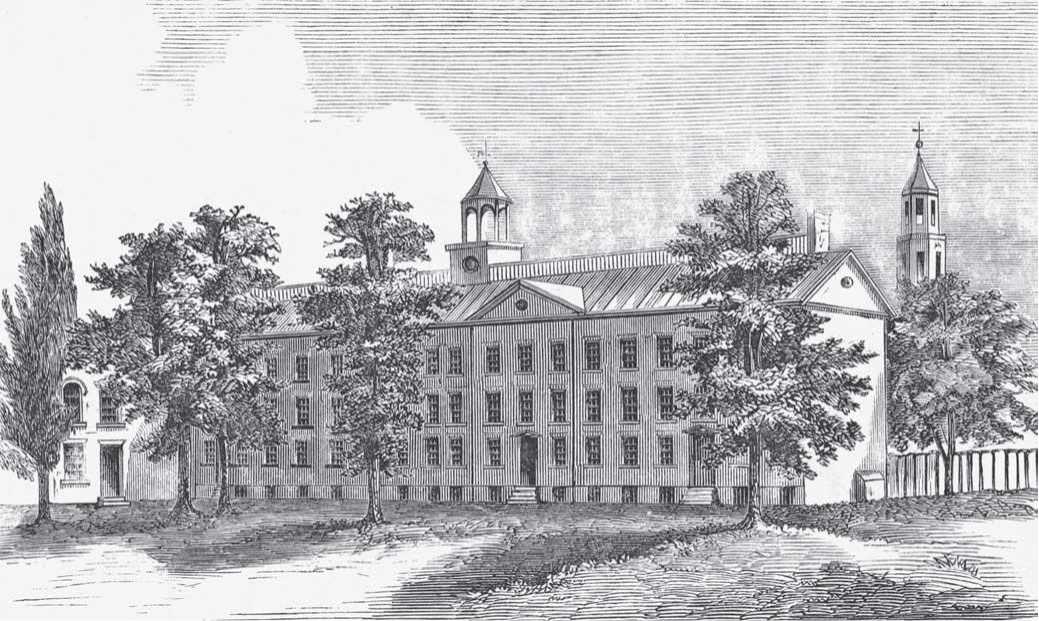The founding of King’s College reflected the ethnic, religious, and cultural controversies that had shaped colonial New York’s society for almost a century before the college opened its doors. The issues of Dutch versus English leadership, of how Anglicized the colony’s culture should become, about battles between locating the center of the colony’s culture in New York City or elsewhere, and about the transformations brought by the Great Awakening all influenced the creation of the school that would one day be Columbia University.
The first mention of a college for the colony of New York was made by Lewis Morris, who described the location as “the center of English American [and] . . . a proper place for a college” in a 1704 letter to the Society for the Propagation of the Gospel in Foreign Parts, but it

An 1859 print of King's College as it appeared in 1756 (New York Public Library)
Was not until 1746 that the colony’s governor, assembly, and council approved a lottery to raise ?2,250 for that purpose. The school immediately became the subject of controversy. First, location was the issue. Advocates of a rural setting, among them Cadwallader Golden, railed against the corruption of New York City, its tippling houses, and other base entertainments, but supporters of an urban college overcame that opposition. They raised ?13,000 and secured land from Trinity Church in 1752 for the college’s location.
The location controversy paled by comparison to the debate over religion at the College of New York. The Rev. Samuel Johnson, a former tutor at Yale College who, like President Timothy Cutler, had converted from Congregationalism to the Church of England, led the charge for New York’s college to be an Anglican institution. Cutler was both enthusiastic for his chosen faith and frightened at the widespread support for the Great Awakening and the colleges it inspired. In 1747 Johnson called the College of New Jersey (Princeton) “a fountain of Nonsense” and was angered that this “dissenting” institution, close to New York, would draw support away from the Anglican school he hoped to found.
William Livingston emerged as the leader of non-Anglicans in the college controversy. Raised in the Dutch
Reeormed Church in Albany, Livingston was a 1741 graduate of Yale who had grown weary both of the religious revivalism going on around him and Thomas Clap’s extreme orthodoxy at the college. Livingston and his supporters called for an enlightened, liberal arts curriculum that left theological study to the private hours of the students.
In November 1751 the New York legislature established a board of trustees comprised largely of Anglicans to oversee the school’s lottery funds. Two years later that board chose Samuel Johnson as the first president of the college. In May 1754 the controversy flared up again, when Trinity Church repeated its offer of land for the college, but now required that its president always be an Anglican and that its religious services always be conducted in the forms of the Church of England. Livingston again led a vociferous opposition, stating that the church was not established in New York, that using lottery funds to support an Anglican institution was an insult to dissenters, that Trinity’s first offer had no such requirements, and that the charter should be submitted to the assembly, not the governor. The trustees ignored the protests by Livingston and others, and on May 20 petitioned the governor and council for a charter. On June 4 Lieutenant Governor James DeLancey ordered the colony’s attorney general to prepare a royal charter. Livingston and his supporters continued their dissent, waging a newspaper war and sending numerous petitions to the colonial assembly. On November 2 the governor signed the charter of the school, now to be known as King’s College. The Anglican-dissenter controversy continued until December 1756, when the assembly agreed to allot half the funds raised by the lottery to the city of New York and half to the college.
Samuel Johnson served as president from 1754 to 1763 and established a curriculum that included the standard liberal arts, languages, and sciences as well as husbandry, surveying and navigation, history, geography, government, and commerce. Johnson’s repeated goal as master of the college was educating and training New York’s future elite in ideas that conformed with the Church of England. He showed little interest in educating pupils outside that goal, including the Society for the Propagation of the Gospel’s plan during the Seven Years’ War to send Indian students to the college.
Further reading: David C. Humphrey, From King's College to Columbia, 1746-1800 (New York: Columbia University Press, 1976).
—George W. Boudreau




 World History
World History



![Stalingrad: The Most Vicious Battle of the War [History of the Second World War 38]](/uploads/posts/2015-05/1432581864_1425486471_part-38.jpeg)





